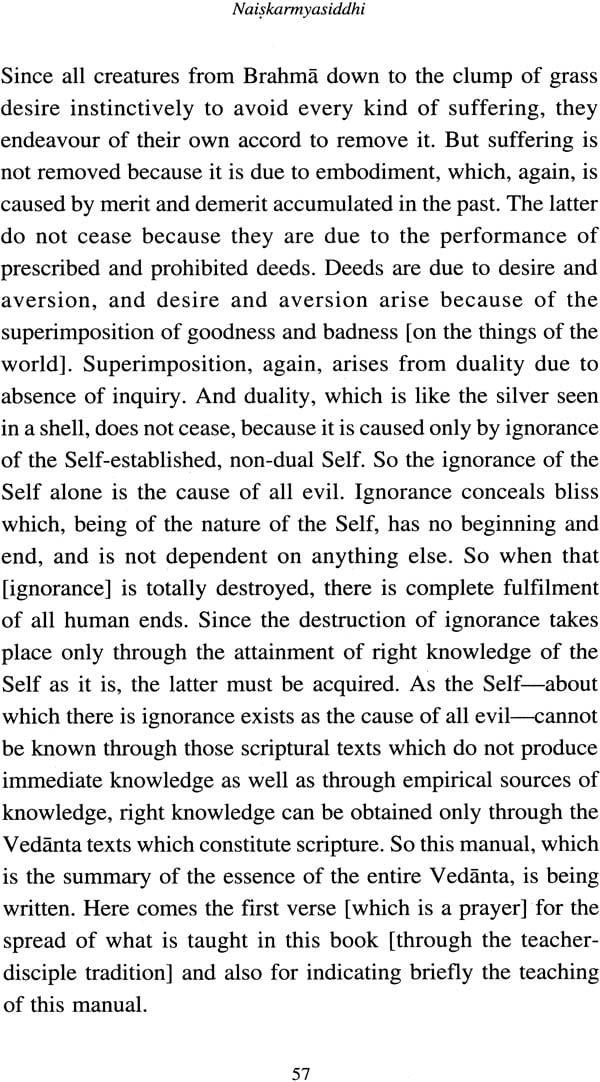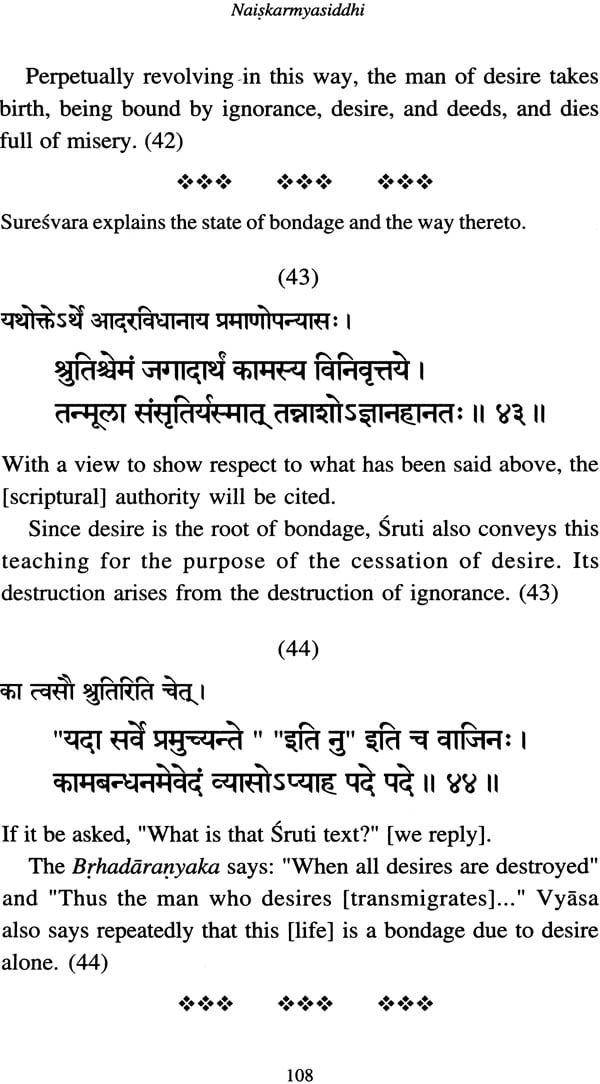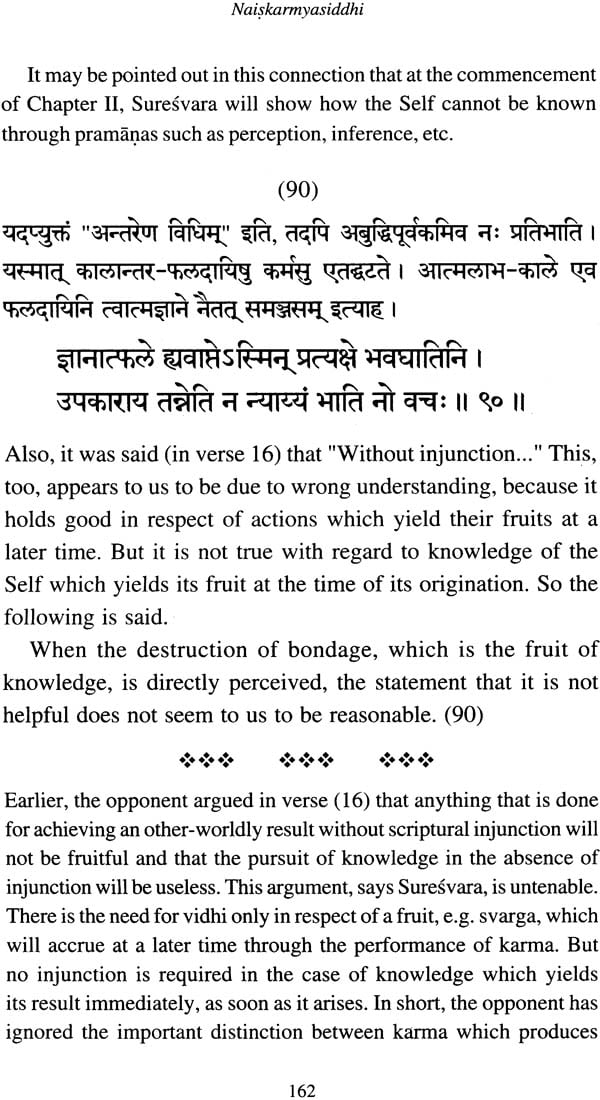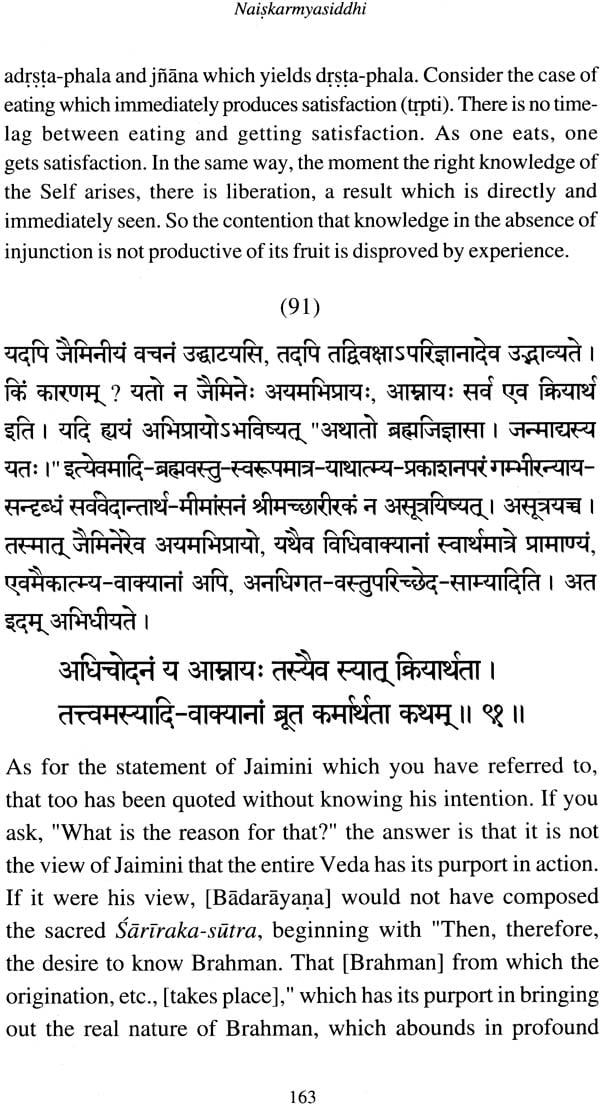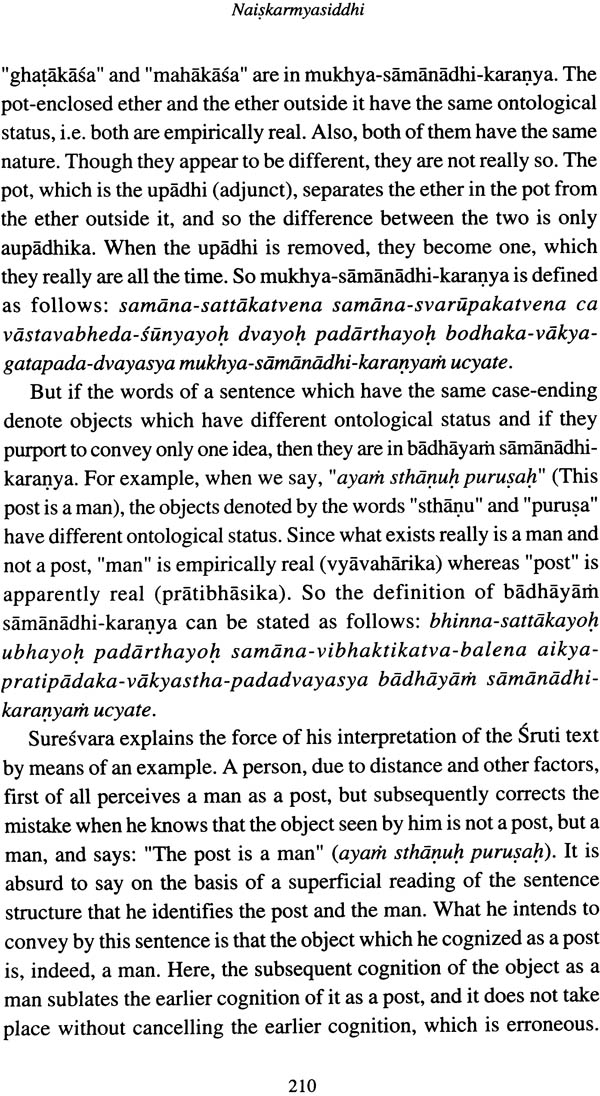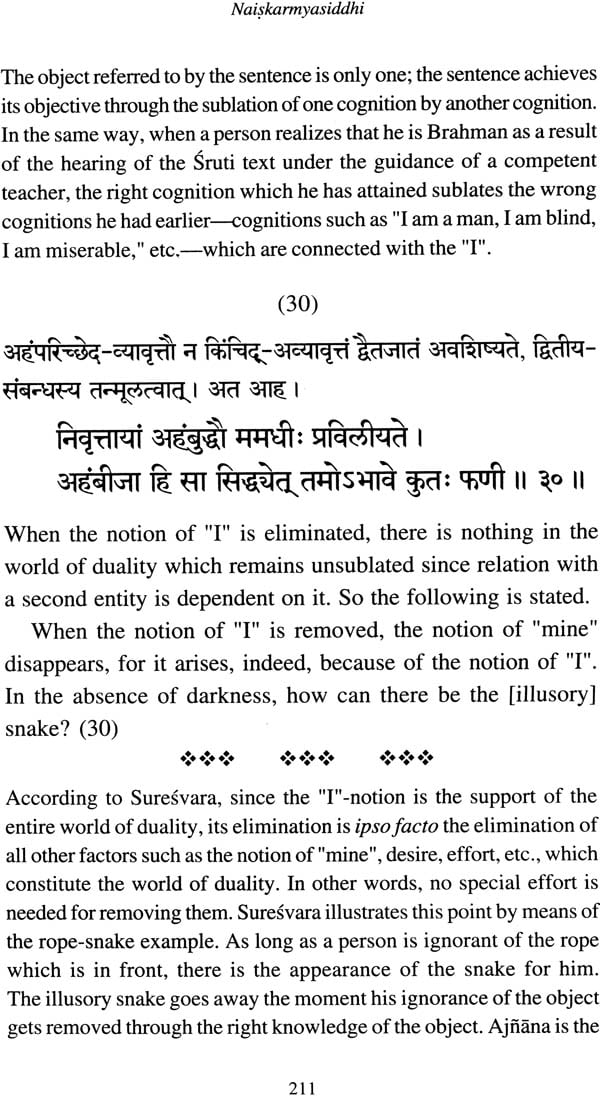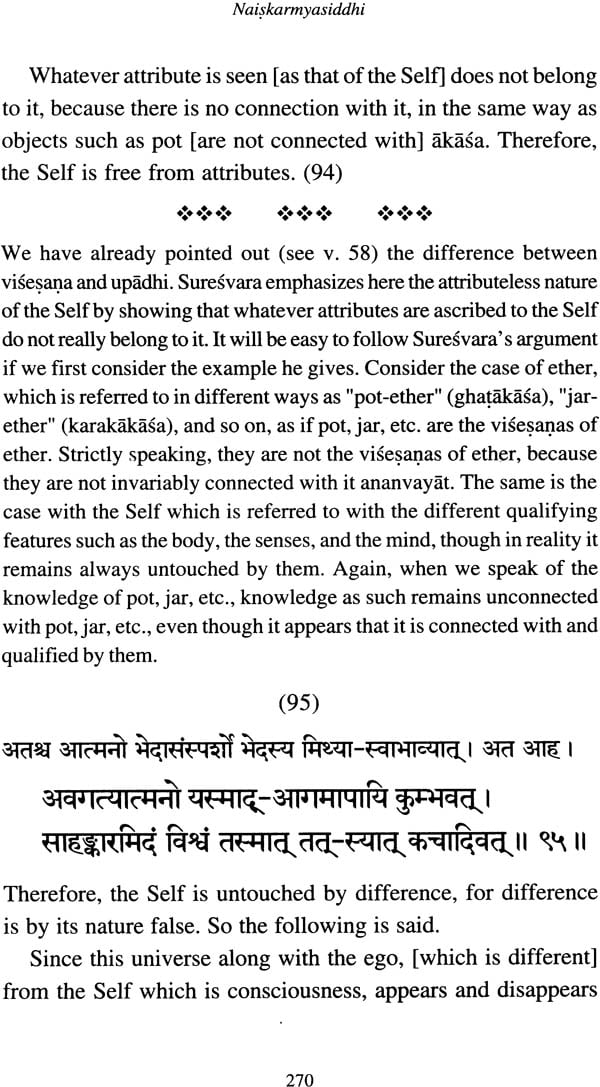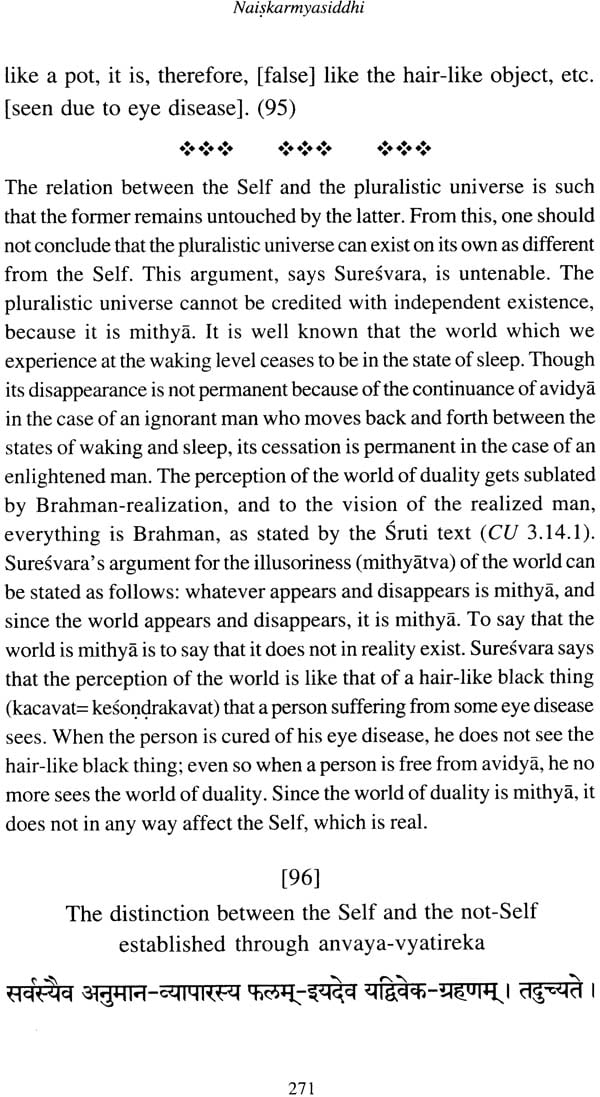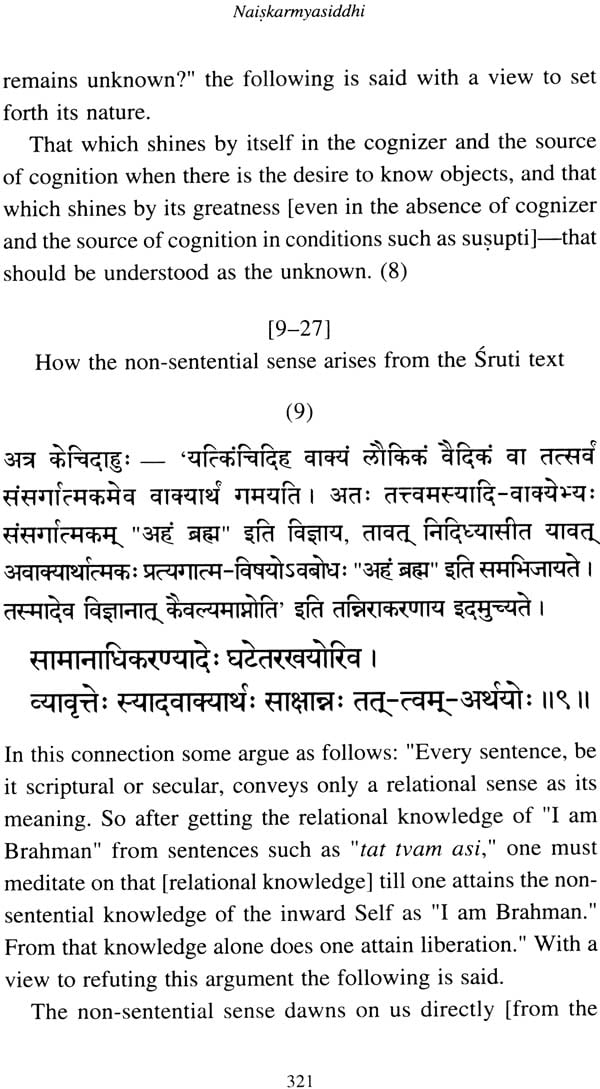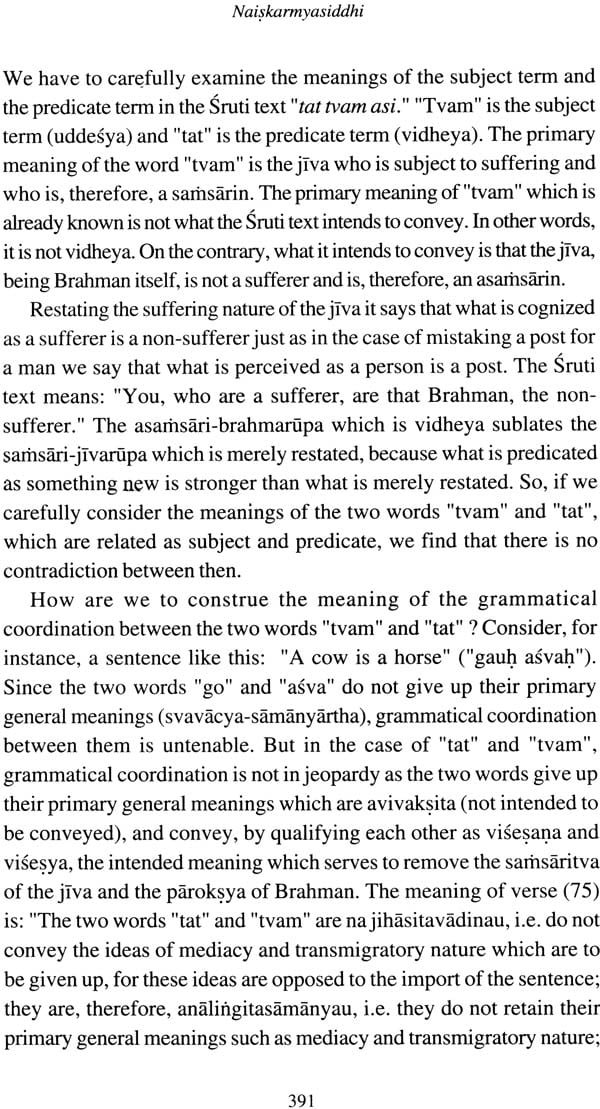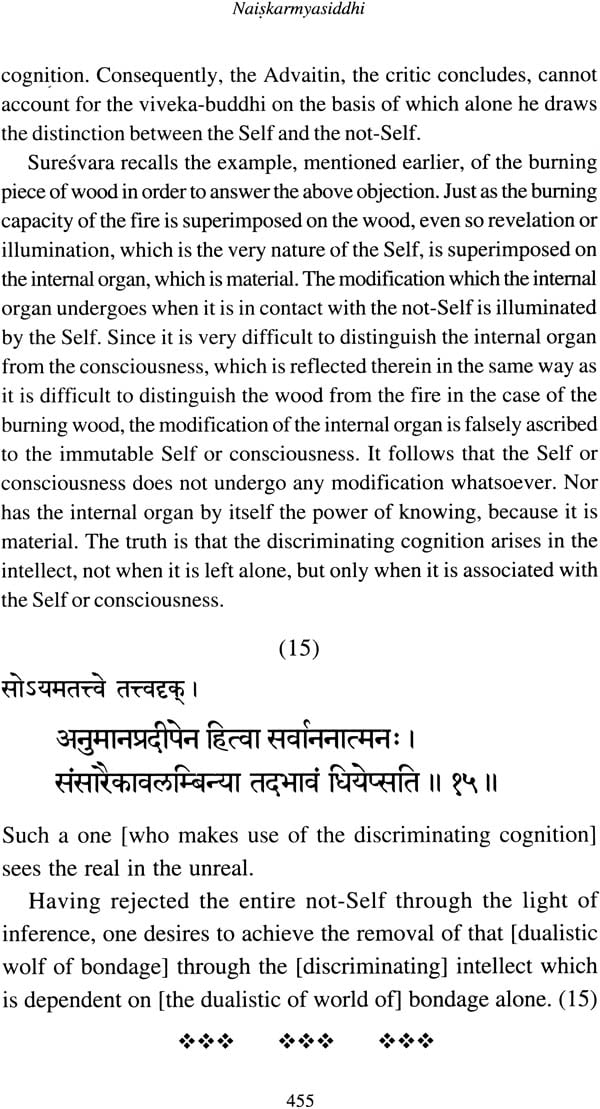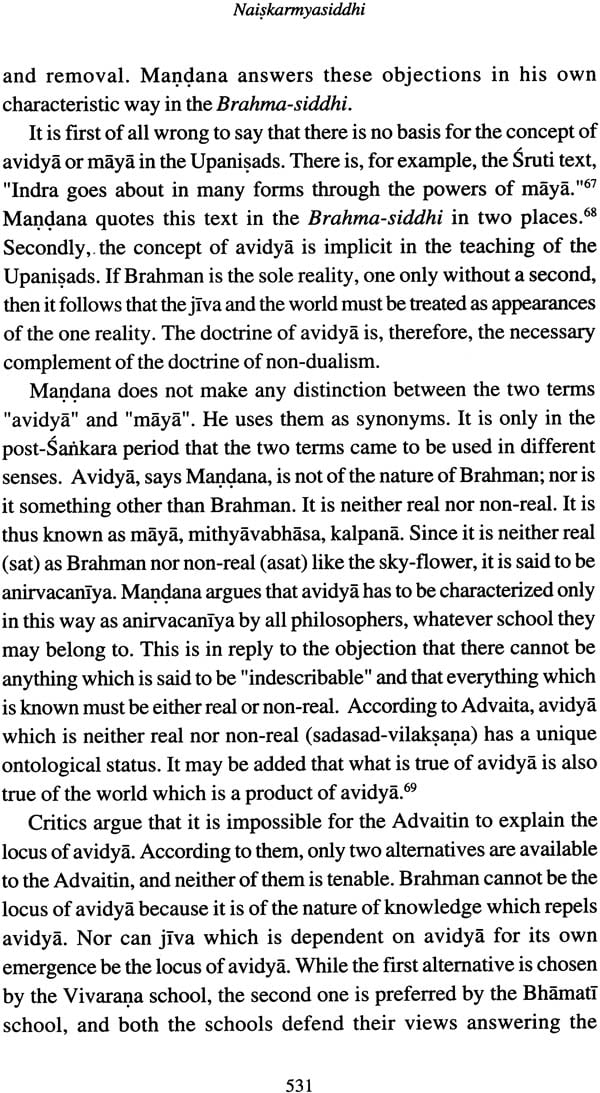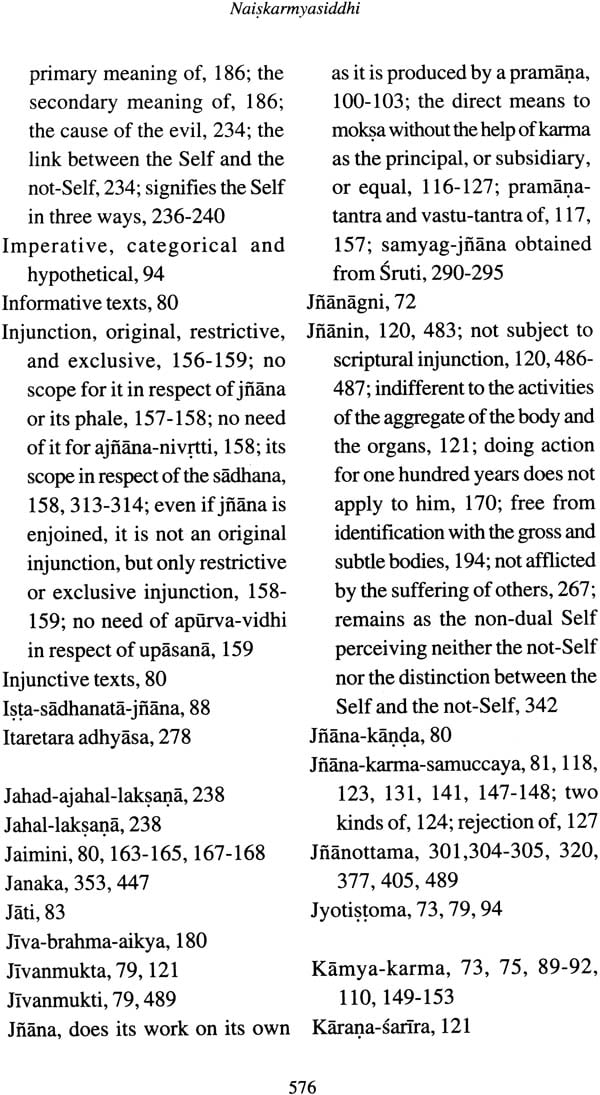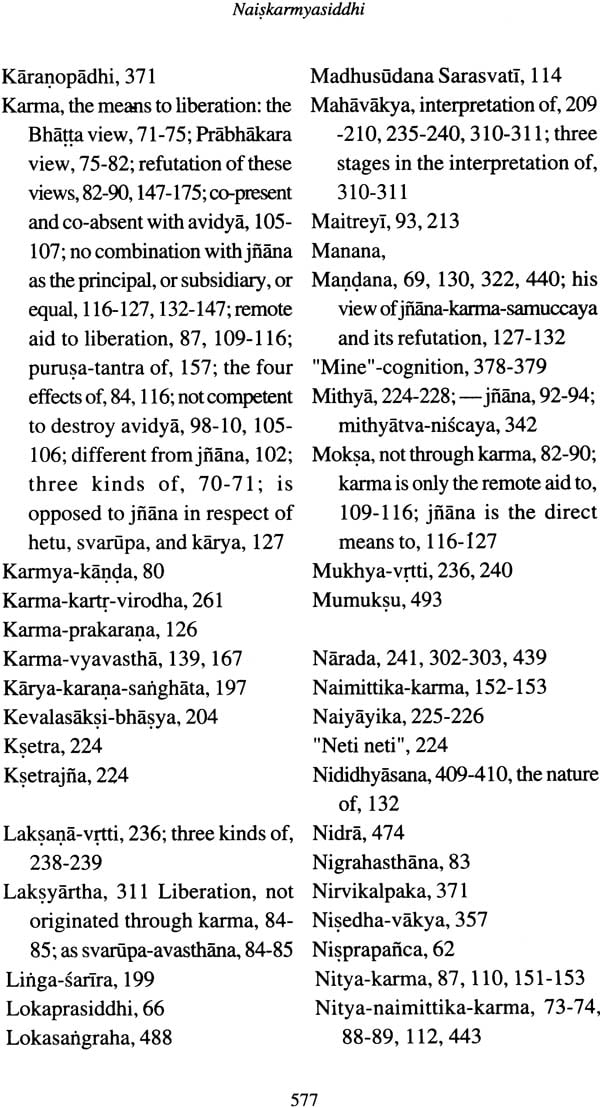
Naiskarmya Siddhi: An Elucidation of Advaita by Suresvara
Book Specification
| Item Code: | NAM520 |
| Author: | Prof. R. Balasubramanian |
| Publisher: | old CHINMAYA INTERNATIONAL FOUNDATION |
| Language: | Sanskrit Text with English Translation |
| Edition: | 2018 |
| ISBN: | 9789380864396 |
| Pages: | 590 |
| Cover: | Hardcover |
| Other Details | 10.0 inch X 6.5 inch |
| Weight | 1 kg |
Book Description
Prof. R. Balasubramanian has led a life fully devoted to Advaita-vedanta. An early scholar from the University of Madras, Prof. R. Balasubramanian retired in 1989 as Professor of Philosophy and Director of the Radhakrishnan Institute of Advanced Study in Philosophy. A former Chairman of the Indian Council of Philosophical Research (ICPR), he has been the recipient of many awards and honours, including the prestigious Lifetime Achievement award from the ICPR in 2010. A disciple of the great classical Sanskrit scholar Pandit Varahur Kalyanasundara Sastrigal, Prof. R. Balasubramanian has to his credit more than 25 books and hundreds of research papers on a wide range of topics, especially Advaita, epistemology and existentialism, which are his fields of specialization. Prof. R. Balasubramanian lives currently in Bengaluru.
Chinmaya International Foundation (CIF), an institute for Sanskrit and Indology research, was established in 1990 by Pujya Gurudev Swami Chinmayananda with a vision of it "being a bridge between the past and the present, East and West, science and spirituality, and pundit and public." CIF is located at the maternal home and hallowed birthplace of Adi Sankara, the great saint, philosopher and indefatigable champion of Advaita Vedanta, at Veliyanad, 35km from Ernakulam, Kerala.
CIF is recognized as a Centre for Excellence in Sanskrit Research (Shodha Sansthan) by the Rashtriya Sanskrit Sansthan, a Deemed University under the Ministry of HRD, Govt. of India and as a Research Centre by the Mahatma Gandhi University and by the Indira Gandhi National Open University (IGNOU). CIF is actively engaged in a multitude of academic projects. It conducts academic seminars and workshops and has online or distance home study courses for Vedanta, Sanskrit, vedic Mathematics and so on. Please visit www.chinfo.org for further information.
The Naiskarmya-siddhi, one of the four important works in the siddhi-literature of Advaita, is a valuable prakarana-grantha written by the great scholar and direct disciple of Sankaracarya, Suresvara, which explains and justifies the doctrines of Advaita in four chapters. It is, in the words of Suresvara, a compendium of the entire philosophy of Vedanta (asesa-vedanta-sara- sangraha-prakaranam). Written partly in prose and partly in verse, Suresvara makes use of the prose element to introduce a wide range of ideas: to state a problem for discussion, to provide an introduction to the verses following or to state an objection of an opposing viewpoint and to counter it. This definitive explanation, notes and commentary on the Naiskarmya-siddhi is replete with Prof. Balasubramanian's scholarship and clear explanations that will be of immense value to any serious student - whether scholar, seeker or beginner - in understanding the fine nuances of Advaita-vedanta.
This volume of the Naiskarmyasiddhi - An Elucidation of Advaita by Suresvara contains the text in Devanagari, with an English translation and annotation. The introduction provides a brief account of the essentials of the philosophy of Advaita as expounded by Acarya Suresvara in the Naiskarmyasiddhi. Prof. R. Balasubramanian has closely followed Jnanottama's brilliant and lucid commentary called Candrikii in his elaborate annotations, amplifying the doctrines and arguments as set forth by Jnanottama. But for Jnanottama's commentary, comprehending certain aspects of the text would have been very difficult. The author has also benefited greatly by Swami Satchidanandendra Saraswati's commentary on the Naiskarmyasiddhi called Klesapaharini (Adhyatma Granthavali Series, Adhyatma Prakasha Karyalaya, Holenarsipur, 1968).
The author has been helped by two previous translations: Prof. S. Raghavachar's edition of the text in Devanagari with English translation and notes had come out as a publication of the University of Mysore in 1965. A. J. Alston had brought out his translation along with text in the romanized form (Shanti Sadan, London) under the title The Realization of the Absolute. Prof. R. Balasubramanian has followed Mr. Hiriyanna's edition of the text (Bombay Sanskrit and Prakrit Series, No. XXXVIII, 1925) with the Candrika of Jnanottama, albeit preferring a few changes in the readings.
Prof. R. Balasubramanian has also studied the Vedanta texts from his revered teacher, Bhasyabhavajfia Sri Varahur Kalyanasundara Sastri. Having read the text of the Naiskarmyasiddhi with the Candrikii more than once under his guidance, the author takes this opportunity to express his gratitude to his teacher for his help and guidance.
It was Prof. R. Balasubramanian's ardent wish that Chinmaya International Foundation (CIF) bring out his commentary on the Naiskarmyasiddhi. When his health was declining, CIF was not sure how to proceed further in this work and fulfill his request. Sri Rajangam, Smt. Dharini Rajangam and Smt. Syamala Raman (his family members) enabled CIF to get the documents that had been paginated by his typist Smt. Jayanti. CIF is deeply grateful to Prof. R. Balasubramanian's family for their help with the manuscripts.
The CIF team undertook the task of preparing the manuscript thus handed over by Prof. R. Balasubramanian's family. Swami Sharadananda initiated the proofreading of Devanagari portions and Shri Anant Basudev Nanda, Curator, CIF Shodha Sansthan, completed it. Dr. (Smt.) Arundhati Sundar and Yuvaveer Gaurav helped in editing the index. Smt. Sandhya Sundar scrutinized the entire English portions with utmost dedication and love. Br. Sundar Chaitanya perfected the pagination and the final draft with perseverance and devotion. Br. Kutastha Chaitanya assisted in all the above works and swiftly coordinated the preparation of the beautiful cover page design with Renjith. Shri Manikandan of Garuda Graphics facilitated the printing of the book. My gratitude to all the above. May the grace of the Lord and the blessings of Pujya Gurudev Swami Chinmayananda be on all. The encouragement of Pujya Guruji Swami Tejomayananda, the Head of the Chinmaya Mission, is our strength to complete this work.
It is indeed a triumph of many hands that Prof. Balasubramanian's scholarly book is being presented to the students of Vedanta. With its lucid commentaries and in-depth explanations, every student of this great book of Acarya Suresvara will without doubt be deeply indebted to Prof. R. Balasubramanian.
Well-known as the Vartika-kara in the Advaita tradition, Suresvara is venerated as the authentic spokesman of Sankara. Though a disciple of Sankara, he is respected as much as his Master for consolidating the great tradition of Advaita which was systematized by Vyasa (Badarayana) in the form of aphorisms. In the prefatory remarks to the Vedanta- kalpalatika, Madhusudana Sarasvati says that he sets forth in measured words the true sense indicated by Vyasa, Sankara, and Suresvara after refuting the views of Jaimini, Patafijali, Gautama, Kanada, Kapila, and others. The fact that Madhusudana Sarasvati places Suresvara in the galaxy of Vyasa and Sankara is, indeed, a just and splendid tribute to Suresvara whose authority is invoked by many an Advaitin.
It is easy to narrate the life-history of Suresvara. It is the story of a life of polar opposites. Being the story of a Mimamsaka-turned Advaitin, it presents pictures of two opposing stages of life, one following the other, as a result of philosophico-religious conversion-that of a fervent champion of the philosophy of action on the one hand and that of an ardent advocate of the philosophy of know ledge on the other; that of a zealous house-holder on the one hand and that of a committed renunciate on the other. According to tradition, Suresvara was known in his purvasrama as Mandana and Visvarupa before he became a sannyasin-disciple of Sankara. The information contained in Vidyaranya's Sankara- digvijaya is very significant. Vidyaranya tells us that Kumarila advised Sankara to defeat Mandana who was a reputed householder (mahagrhi), who scrupulously adhered to the path of action (karmatah), who opposed the path of renunciation, and who was a great scholar in the different branches of learning (sarvasu sastra- saranisu sa visvarupah). This is stated in verses (111) to (117) of the seventh canto of this work. Vidyaranya also tells us that Mandana became a sannyasin when he was defeated by Sankara according to the promise given to the latter and that he assumed the name of Suresvara. This is described in verses (74) and (75), and verses (104) to (106) of the tenth canto of this work. It is evident from what has been stated above that, according to the tradition known to Vidyaranya and others, Suresvara is identical with Mandana and Visvanipa and that Mandana, when defeated by Sankara, renounced the world, was initiated into sannyasasrama, and became a devoted disciple of Sankara under the new name of Suresvara. It is easy for us to assess the importance of Suresvara in the school of Advaita against the background of his life-history. First of all, his defence of Advaita and trenchant criticism of Mimamsa as well as other schools assume a decisive importance inasmuch as they come from one who was previously a Mimarnsaka. It must be borne in mind that the entry of the Mimarnsa- entrenched-Mandana into Advaita was not easy and quick, nor was it in a fit of emotion. Tradition holds that he defended the Mimarnsa position in a prolonged debate with Sankara for several days before admitting defeat and becoming a sannyasin-disciple of Sankara. His donning ochre robes meant a great deal more than mere change in external appearance. It was the external symbol of fire-baptism which made him emerge as a spiritually regenerate person. It brought a new awakening in him. So his defence of Advaita and his criticism of Mimarnsa and other schools arise from his new enlightenment. Secondly, his Vartikas and other works are considered to be as authoritative as the writings of Sankara, His works are great because they constitute a great philosophical literature in Advaita composed by a person of eminence and force of intellect.
The Naiskarmya-siddhi, one of the four important works in the siddhi-literature of Advaita, is a valuable prakarana-grantha of Suresvara, which explains and justifies the doctrines of Advaita in four chapters; it is, in the words of Suresvara, a compendium of the entire philosophy of the Vedanta (asesa-vedanta-sara-sangraha-prakaranam). It is partly in prose and partly in verse. Though the verses by themselves provide a complete account of Advaita in all its aspects, the prose part called 'sambandhokti' cannot be ignored or dismissed as unimportant. Suresvara makes use of it for several purposes-to introduce a problem for discussion, to provide an introduction to the verse or verses following it, to explain the relation between the verses, to state an objection of the opponent and the reply thereto, and to summarize the points at a particular stage for the purpose of recapitulation. The prose part is, therefore, helpful for the easyand proper comprehension of the doctrines and arguments of Advaita.
There is a traditional story connected with the writing of the Naiskarmya-siddhi. It is said that Sankara wanted Suresvara to write a Vartika on his commentary on the Brahma-sutra. This was not to the liking of the other disciples who thought that Suresvara might not have been sincere in his conversion and that, if entrusted with the writing of a Vartika on the Sutra-bhasya of Sankara, he might misinterpret it. Sankara, therefore, directed Suresvara to write an independent work on Advaita. Accordingly, Suresvara wrote the Naiskarmya- siddhi. He says in this work that he expounds the knowledge of Brahman-Atman, which is contained in the heart of the Upanisads and which puts an end to the life of samsara, in obedience to his preceptor's order, though it has been explained by others also.
The Manasollasa, which is another work of Suresvara, is a running metrical explanation of Sankara's Daksiruimiirti-stotra. One of the notable features of this small work is the reference it contains, in the course of the explanation of the second stanza of the hymn, to the Vaisesika, Sankhya, Pauranika, and Saivagama categories, the theories of causality, and the sources of knowledge accepted by the different systems, for the purpose of vindicating the Advaita doctrine of maya by refuting all of them. "All the principles thus assumed," says Suresvara, existed in the Self before, as the plant in a seed. By maya, acting, have they been displayed.
Contents
| Preface | III | |
| Abbreviations | X | |
| Introduction | 1 | |
| | ||
| 1 | Introduction and Invocation | 56 |
| 2 | Salutation to his Teacher | 63 |
| 3 | Reason for writing the book | 64 |
| 4 | Subject-matter of the book | 65 |
| 5 | The authority of his Teacher | 67 |
| 6 | The author's desire for clarity of understanding | 68 |
| 7 | Evil and the cause of evil | 69 |
| 8 | The means and the end | 70 |
| 9 | Karma: the means to moksa: the view of the Bhattas | 71 |
| 10 | Karma: the means to moksa: the view of the Prabhakaras | 75 |
| 11 | Karma is not the means to moksa | 82 |
| 12 | A vidya, the root cause of bondage, can be destroyed only by knowledge | 90 |
| 13 | The work of Sruti as a pramana | 94 |
| 14 | Two kinds of attainment and two kinds of avoidance | 96 |
| 15 | Knowledge, not karma, destroys ignorance | 98 |
| 16 | Knowledge, generated by a pramana, does its work on its own, without depending on anything else (36-37) | 100 |
| 17 | Knowledge can never be sublated by avidya and its impressions | 103 |
| 18 | Co-presence and co-absence of avidya and karma | 105 |
| 19 | The course of bondage | 107 |
| 20 | Karma: the remote means to liberation | 109 |
| 21 | Jnana, the direct means to liberation without the help of karma as the principal, or subsidiary, or equal | 116 |
| 22 | The refutation of the views of Brahmadatta and Mandana: no scope for bhavana or jnana-karma-samuccaya after the rise of knowledge | 127 |
| 23 | No scope for jnana-karma-samuccaya even if one were to accept bhedabheda | 132 |
| 24 | Conclusion of the refutation of jnana-karma-samuccaya | 147 |
| 25 | Refutation of the arguments of the Bhattas and of the Prabhakaras | 148 |
| | ||
| 26 | The way to understand the Sruti text "tat tvam asi" | 176 |
| 27 | The opponent's view that Brahman-Atman can be known through other sources as well, independently of Sruti | 180 |
| 28 | Refutation of the opponent's view | 183 |
| 29 | From dispassion to the destruction of ignorance | 187 |
| 30 | The Self is different from the gross body | 189 |
| 31 | The Self different from the subtle body | 198 |
| 32 | So the entire not-Self which is caused by avidya is different from the Self | 224 |
| 33 | The false appearance of duality | 227 |
| 34 | How the Self is signified by the "I" | 235 |
| 35 | The nature of the Self: immutable, eternal consciousness | 241 |
| 36 | The distinction between the Self and the not-Self established through anvaya-vyatireka | 271 |
| 37 | The not-Self comprising everything from Brahma down to the clump of grass is dependent on the Self | 272 |
| 38 | Because of its immediacy, the Self is aprameya | 274 |
| 39 | The reciprocal superimposition between the Self and the not-Self due to avidya | 277 |
| 40 | The removal of avidya | 279 |
| 41 | The Self is the witness to the factors of action, action, and the result of action | 282 |
| 42 | The right knowledge of the Self obtained through Sruti | 290 |
| | ||
| 43 | The locus and the content of avidya | 296 |
| 44 | The non-sentential sense obtained from the sentence itself | 308 |
| 45 | The three stages one has to go through to obtain non-sentential sense from the sentence | 310 |
| 46 | Injunction only on the jnana-sadhana | 312 |
| 47 | Removal of avidya through scriptural knowledge | 315 |
| 48 | How the non-sentential sense arises from the Sruti text | 321 |
| 49 | Distinction between the Self and the not-Self, known through anvaya-vyatireka, leads to the comprehension of the non-sentential sense | 339 |
| 50 | Removal of avidya, not by the reasoning of anvaya-vyatireka, but only through scriptural knowledge | 344 |
| 51 | Validity of Sruti as a pramana | 346 |
| 52 | Sruti support for the method of anvaya-vyatirddeka | 349 |
| 53 | No conflict between Sruti and other pramanas | 354 |
| 54 | Validity of assertive Sruti texts | 357 |
| 55 | Scope of anvaya-vyatireka reasoning | 363 |
| 56 | The Limitations of inference: the immediate apprehension of the Self is not possible through inference, but only through Sruti | 366 |
| 57 | Distinction between the Self and the "I" | 373 |
| 58 | Conclusion about the limitation of anvaya-vyatireka | 379 |
| 59 | The "tenth man" example | 380 |
| 60 | Destruction of avidya through scriptural knowledge | 382 |
| 61 | Restatement of agency, etc. for the purpose of negation | 388 |
| 62 | Mahavakyas do not enjoin prasankhyana | 395 |
| 63 | No conflict between Sruti and other pramanas | 414 |
| 64 | The Self is signified only indirectly | 415 |
| 65 | Rise of right knowledge from the Sruti text | 421 |
| 66 | Removal of avidya through scriptural knowledge | 431 |
| 67 | Prasankhyana cannot produce immediate knowledge of the Self | 439 |
| | ||
| 68 | The relation between the chapters | 445 |
| 69 | Summary of the teaching | 446 |
| 70 | Summary of Chapter III | 458 |
| 71 | Support from recognized authorities | 458 |
| 72 | The Self untouched by avidya, pleasure, pain, etc. | 475 |
| 73 | The fruit of knowledge | 478 |
| 74 | Conclusion of the Book | 480 |
| 75 | The knower of Brahman is free from scriptural injunctions and prohibitions | 482 |
| 76 | The continuance of the body of the knower of Brahman till the exhaustion of prarabdha-karma | 486 |
| 77 | No erratic action by the knower of Brahman | 490 |
| 78 | Cultivation of moral virtues and practice | 494 |
| 79 | Paragon of virtues | 495 |
| 80 | Eligibility to study this Book | 497 |
| 81 | 81. The saving knowledge communicated through this Book | 498 |
| 82 | Obeisance to Sankara | 500 |
| 83 | The importance of sambandhokti | 500 |
| Appendix | ||
| Mandanamisra and Suresvara: Two Complementary Poles | 501 | |
| Index I | Index of Verses of the Naiskarmyasiddhi | 550 |
| Index II | Index of Scriptural Passages Cited in the Text and Annotation | 568 |
| Index III | Index of Verses from the Upadesasahasri and the Mandukya-karika quoted in the Text | 572 |
| Index IV | Index of Words and Topics | 573 |
Sample Pages

